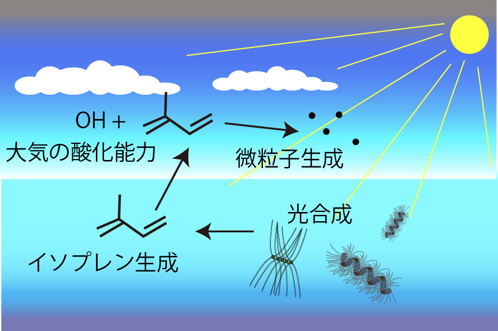Isoprene Production by Phytoplankton
โครงสร้างหัวข้อ
-
-
Prof. Ooki, Laboratory of Marine Environmental Science, Division of Marine Biosphere and Environmental Science
-
-
Isoprene (
 ) is a hydrocarbon with two double bonds, and its chemical formula is C5H8
) is a hydrocarbon with two double bonds, and its chemical formula is C5H8Plants synthesize organic matter, such as carotene, using isoprene units (
 ). Because
isoprene is highly volatile, it has been shown to be released outside the plant
during photosynthesis. Atmospheric isoprene derived from plants accounts for a large portion of natural organic gas. Isoprene is also released from
marine plants, and it is thought to change the oxidation capacity of the marine
atmosphere. In the dark, where photosynthesis is not possible, plants decompose
carotene to obtain energy. Isoprene is likely to be released at this time as
well. In this
research,
we investigate
the production rate of isoprene by oceanic phytoplankton communities, as well
as the production in the dark.
). Because
isoprene is highly volatile, it has been shown to be released outside the plant
during photosynthesis. Atmospheric isoprene derived from plants accounts for a large portion of natural organic gas. Isoprene is also released from
marine plants, and it is thought to change the oxidation capacity of the marine
atmosphere. In the dark, where photosynthesis is not possible, plants decompose
carotene to obtain energy. Isoprene is likely to be released at this time as
well. In this
research,
we investigate
the production rate of isoprene by oceanic phytoplankton communities, as well
as the production in the dark.
-
-
-
The Funka bay in Hokkaido, Japan, faces the Western North Pacific Ocean. Open ocean water flows into the bay twice a year in spring and autumn. The waters stay in the Funka bay during a certain period of summer and winter. The Funka bay is a model sea area, where we can examine the water quality changes in time series within the same water mass.
The Training Ship Ushio-maru is used mainly to observe the coastal area in Hokkaido. This survey measures not only basic ocean parameter such as water temperature and salinity, but also organic gas components including isoprene, nutrients, and dissolved inorganic carbon.

-
-
-
Chlorophyll concentration (right chart): Chlorophyll concentration increased rapidly in all layers from February to March. This is because of the spring bloom of diatoms. The high concentration of chlorophyll found at the deepest bottom layer is due to the sedimentation of aggregates of diatom grown on the surface.
Isoprene concentration (left chart): Isoprene concentration increased in the mixed layer from February to March. This is due to the release of isoprene by photosynthesis of phytoplankton in the diatom bloom. Isoprene concentration increased even in the dark bottom layer For the first time, we could observe the production of isoprene in the dark.
-
-
-
Isoprene is decomposed by bacteria as it is produced by phytoplankton in seawater. We need to investigate the effect of bacterial degradation of isoprene.
Oxygen and isoprene are produced by photosynthesis in plants. It is expected that the net production of oxygen and isoprene will be used to estimate the ocean primary production over a period of time.
-
